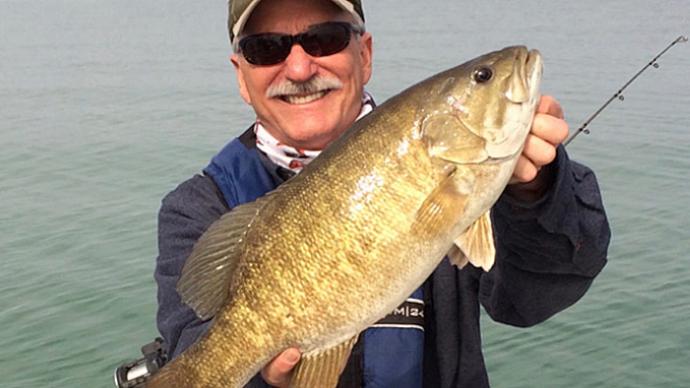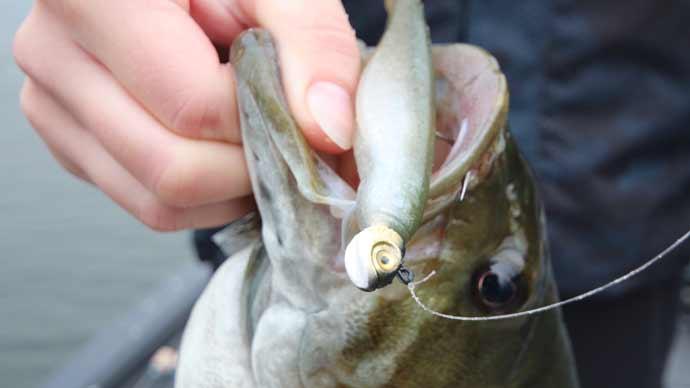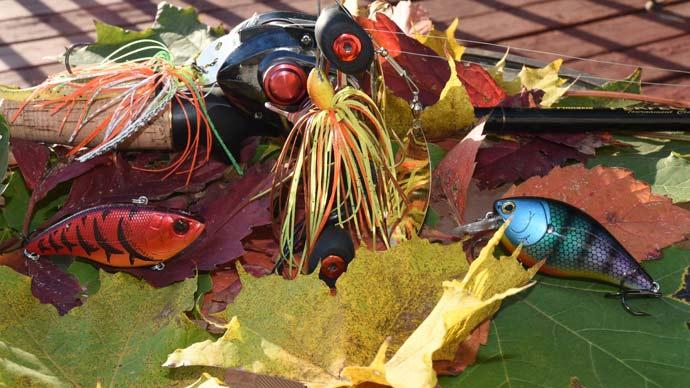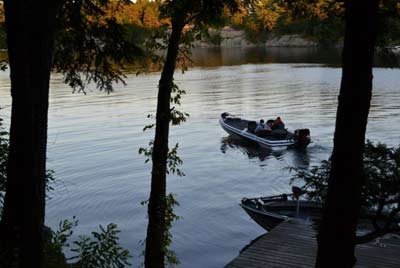
It can happen while walking around your neighborhood, heading to the store, or mowing your lawn. But there’s no mistaking that first breath of cool and humidity-free autumn air.
Not many things are as welcome as fall weather, especially after a long summer of heat and humidity, day after day. The change adds pep to your step. It removes pleasure boaters from your favorite fishing spots. And it means bass will soon strap on the feedbag and congregate on specific spots. There are many reasons to be excited about being on the water during fall.
But successful fall fishing doesn't just happen. To catch more and bigger bass, you need to understand how they react to the changing conditions, most noticeably decreasing daylight and cooling water temperatures. Apply that information to your favorite water, and you’ll be well prepared.
You don't have to wait for fall to arrive fully. Preparations can start now, even if the weather is still summerlike. Focus on these four points, and you’ll be ready for when it does.
Scout Some Spots
Image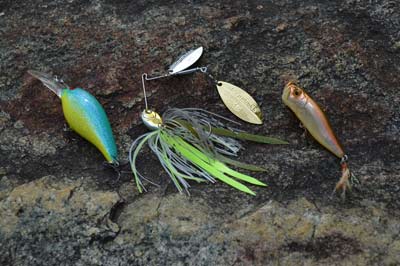
Bass bite various baits in fall, though all resemble baitfish and are small in profile. So, have a selection ready to fish, including topwaters, crankbaits, and double-willow spinnerbaits. Photo by Pete M. Anderson Manmade reservoirs are filled with classic deep-water structure such as ledges and creek channels. But fall fishing is about shallow water, especially flats in dead pockets and the back of creeks. Shad head there as the water temperature and daylight hours drop, searching for favorable conditions. Bass follow these baitfish, feeding at every opportunity. Swirls on the surface give away their presence.
The time to find these spots is before shad and bass arrive. Both are easily spooked by boat noise and errant casts in shallow water. So, find time to run over them with your traditional 2-D sonar, searching for swatches of hard bottom, subtle ledges, or narrow creek channels. In addition to cover, bass use the latter two as “roads,” following them into and out of these spots.
Keep an eye open for pieces of isolated cover. They’re visible during summer’s low water but quickly disappear as reservoirs respond to autumn’s rain. Bass use them as ambush points, waiting for baitfish schools to swim past. While you won’t get a bite each time to run your lure past one, you'll have more success by day's end if they draw most of your presentations.
Isolated cover comes in a variety of forms. Some of the best include:
- Docks: Start with those furthest back in a creek or cove, especially isolated ones. Each can hold multiple bass, so make more than one cast.
- Stump or rock: Isolated ones are best, which often appear as a dark spot just under the surface. They’re even better if they’re next to a ledge or channel.
- Laydown: These tangles of branches often hold more than one bass, especially if they are near slightly deeper water.
Bass in natural lakes also swim toward shallow water in the fall for the same reasons — food and water quality. But they typically travel shorter distances than their reservoir cousins, and most stay in one general area longer. Much of that has to do with the increased amounts of cover found in natural lakes. Concentrate your fishing on these types of spots:
- Inside edge of aquatic vegetation: This spot flies under many anglers’ radar. But the nooks and crannies along these stretches, which often abut hard bottoms, are prime ambush spots.
- Windblown points and shoals: Smallmouth gravitate to these spots, forming small wolf packs to hunt baitfish schools. Isolated patches of aquatic vegetation or boulders add ambush points, making a spot better.
Don't overlook rivers during fall. Cooling water temperatures push bass into schools, which feed in predictable locations. So, instead of covering miles of river in search of bites, you can focus on specific spots. But unlike bass in reservoirs and lakes, these gravitate toward deeper water. Here are two places to check:
- Outside bends: These stretches have deeper water and slower current. Bass will hold here, sometimes moving closer to more current to feed.
- Backwater holes: Their depth is relative. Some may be only 10 feet deep but hold bass throughout winter. The best are in upstream backwaters, keeping muddy water from inundating them.
Watch The Weather
Weather is the most unpredictable part of bass fishing. Every angler has stories of planning a fishing trip based on a forecast, only to change it at the last minute because of actual conditions. Staying on top of it requires short- and long-term approaches.
Image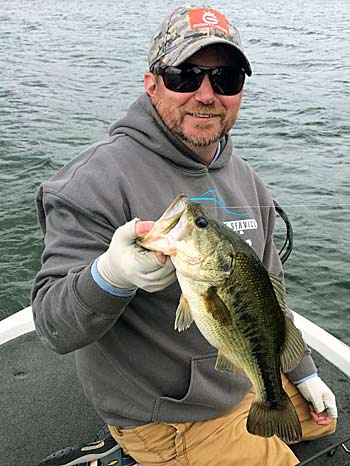
Day-to-day weather changes affect fishing. But keep an eye on longer trends. A rainy summer, for example, can add water to reservoirs, putting into play spots you can’t reach during drier years. Photo by Pete M. Anderson Monitor the wind for a couple of reasons. The first is safety. Wind-whipped water can be dangerous to navigate, especially on large bodies of water. Even a small shift in direction or increase in velocity can create significant changes in waves. So, always watch it when on the water.
Wind direction positions baitfish in a roundabout way. The microscopic organisms that baitfish eat are at the mercy of the wind. They end up on downward shores, and in turn, baitfish follow. Bass aren’t far behind. So, consistent wind from one direction can lead you to hot spots. And a change in wind direction can lead you to others.
Wind affects water clarity, too. For example, a consistent breeze on a muddy bank will create a mud line. Bass use it as an ambush point, ducking in and out to capture baitfish. Runoff creates a similar effect, though it’s usually seen across a larger area, and the water is stained, not muddy. Bass will gravitate to stained water, where the added concealment will give them the confidence to feed.
Precipitation requires a long-term approach. A soggy summer, for example, will raise water levels, creating more places to fish. Dry summers have the opposite effect, making some shallow spots too shallow when fall rolls around.
Prep Your Tackle
Finding fall fishing success starts with finding the best spots. But you need the right tools, too. This selection of lures offers options. But they all have something in common: a small stature.
- Crankbaits: Pack your tackle box with three types. Use rattling lipless ones to cover shallow water for smallmouth and largemouth. Shallow divers will explore skinny water; medium divers will help you keep up with bass as they slide into deeper water.
- Spinnerbaits: Lean on the extra flash of double-willow models in fall’s clear water. Small ¼-ounce models are perfect for largemouth schooling on shad. Larger ½-ounce ones can be ripped under the surface for smallmouth or slow rolled for slightly deeper largemouth.
- Topwaters: Buzzbaits, walking topwaters, and poppers continue to produce as the water temperature cools into the 50s. Large ones can be used to call up bass from slightly deeper water.
- Soft plastics: Texas-rigged worms are an excellent choice for targeting bass along the inside edges of aquatic vegetation. Grubs and tubes, rigged on 1/8- or ¼-ounce lead heads, will catch smallmouth schooling in rivers.
- Jigs: Traditional skirted bass jigs are an excellent choice for shallow-water largemouth. But as fall’s coldest water sets in, try bladed jigs for deep-water smallmouth.
Each of these lures requires a particular combination of rod and reel. Jigs, for example, can be presented on a fast-action flipping stick and baitcasting reel. But crankbaits need a slow-action rod, whose parabolic bend will help keep bass hooked on trebles.
But there are similarities between them, especially when it comes to line. Water tends to be clear, so use monofilament and fluorocarbon lines. Not only are they nearly invisible underwater, but they cast easily. And longer casts mean you aren’t as likely to tip off your presence to wary bass.
Track The Temperature
While the amount of daylight is believed to push bass in specific directions, water temperature significantly influences how quickly they get there, depending on the season. Slightly warmer than usual temperatures, for example, keep aquatic vegetation green longer, giving bass a reason to stick around. Use these temperature ranges to help determine bass location.
- Above 70 degrees: Bass cling to typical summer situations. Those can be ledges and offshore structure in reservoirs and deep weed edges on natural lakes.
- 70 degrees to 60 degrees: Fall movements begin, usually toward shallow water. Bass will use many of the same structures and covers — creek channels, points, cover edges — that they used earlier in the year when they headed to spawning spots from wintering holes.
- 60 degrees to 50 degrees: The shallow-water bite is strong. Reservoir bass are herding schools of baitfish in dead-end pockets and across flats in the back of creeks. Bass in natural lakes are cruising shallow edges of aquatic vegetation and hunting in wolf packs across windswept shoals.
- Below 50 degrees: Some bass will remain in shallow water, especially in Southern reservoirs. Most will retreat to deeper water. River bass, for example, will seek out wintering holes, which feature little to no current, some sort of vertical structure, and plenty of baitfish.
While you’ll want to check the air temperature for your comfort, don't let it confuse you on bass location. While a quick cold front may push you into cold-weather gear, it will have little-to-no effect on water temperature.


